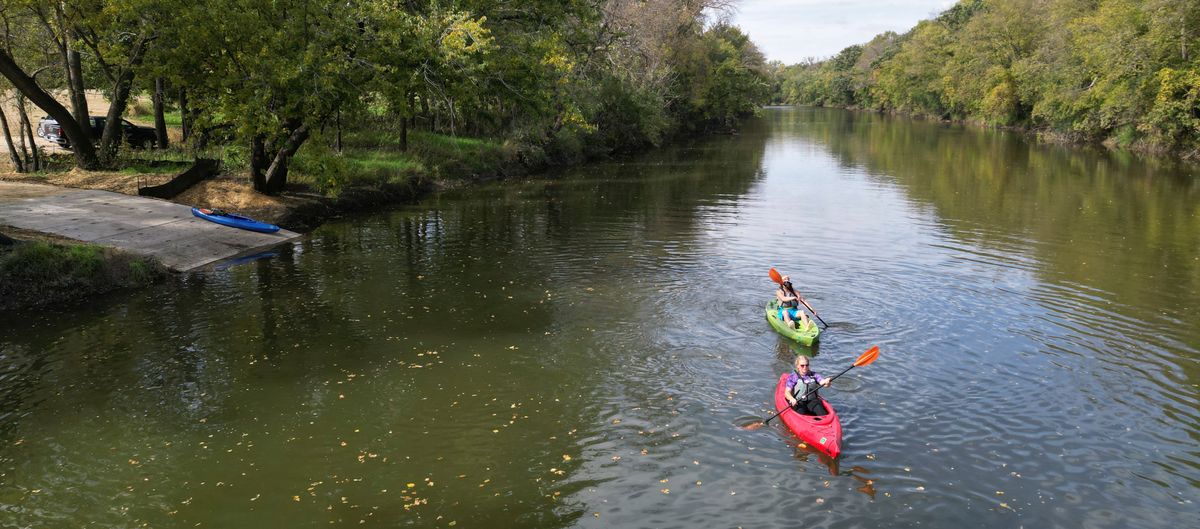Special government authority could take over Wedgefield water, wastewater systems – Central Florida Public Media

Report on the Proposed Acquisition of Wedgefield Water Systems and Alignment with Sustainable Development Goals
1.0 Introduction
Orange County Commissioners have unanimously approved a motion allowing the Florida Governmental Utility Authority (FGUA) to conduct due diligence for the potential acquisition of the privately-owned water and wastewater systems in the Wedgefield community. This action addresses long-standing infrastructure and service issues, aligning with a comprehensive strategy to meet key United Nations Sustainable Development Goals (SDGs).
2.0 Infrastructure Deficiencies and Impact on SDG 6: Clean Water and Sanitation
The current systems, owned by Pluris, are in a state of significant deterioration, posing a direct threat to the provision of safe and reliable water services, a cornerstone of SDG 6 (Clean Water and Sanitation). An evaluation by Orange County Utilities identified critical failures:
- Both water and wastewater systems are deemed to be in a “substandard state.”
- The infrastructure requires “extensive rehabilitation” to meet operational standards.
- The wastewater treatment plant is so compromised that repair “is not economically viable,” necessitating a complete replacement to ensure safe sanitation and wastewater management for the community.
These conditions undermine the core targets of SDG 6, which call for universal and equitable access to safe drinking water and adequate sanitation for all.
3.0 Community Impact and Social Sustainability Goals
The failing infrastructure has created significant social and economic hardships for Wedgefield residents, highlighting challenges related to several SDGs.
3.1 SDG 11: Sustainable Cities and Communities
Residents report persistent issues that detract from a safe and sustainable living environment, a key objective of SDG 11. These include poor water aesthetics and odors, with some describing the water as smelling like sewage. Furthermore, the hard water quality has led to recurring damage to household appliances, such as water heaters and dishwashers, impacting the quality of housing and basic services.
3.2 SDG 10: Reduced Inequalities
A significant disparity exists in utility costs. Wedgefield residents pay approximately 209% more for water and wastewater services compared to other residents of Orange County. This economic burden represents a stark inequality, contrary to the principles of SDG 10. The proposed acquisition by FGUA is anticipated to normalize these rates, potentially reducing them and alleviating financial pressure on the community.
4.0 Proposed Solutions and Governance
Several acquisition scenarios were considered, with the FGUA-led option emerging as the most viable path forward. This approach is seen as a strategic partnership to achieve sustainable outcomes.
4.1 The Role of FGUA in Achieving SDG Targets
The FGUA is a special purpose government entity whose primary mission is to acquire and rehabilitate poorly-functioning water and wastewater systems. This mission is directly aligned with achieving SDG 6. The potential acquisition, estimated at $83.4 million, would leverage FGUA’s expertise and strong track record in securing state grant funding for infrastructure projects.
4.2 Alternative Scenarios and Financial Burdens
Other options would have placed a direct financial lien on residents through a Municipal Service Benefit Unit (MSBU), a special taxing district. These alternatives were less favored due to the long-term tax burden they would impose on homeowners, which could exacerbate inequalities (SDG 10) and affect property values.
5.0 Environmental Risks and SDG 14: Life Below Water
The continued deterioration of the wastewater system presents a severe environmental risk. Commissioner Kelly Martinez Semrad highlighted the dire consequences of a potential system failure:
- Catastrophic damage to approximately 1,800 homes.
- Discharge of raw sewage directly into the St. Johns River Basin.
- Significant cleanup costs borne by all county taxpayers.
A sewage discharge would cause severe pollution to a major waterway, directly contravening the objectives of SDG 14 (Life Below Water), which aims to prevent and significantly reduce marine pollution of all kinds.
6.0 Conclusion: A Partnership for Sustainable Development
The decision to authorize FGUA exploration represents a critical step toward resolving the long-standing utility crisis in Wedgefield. This collaborative approach, an example of SDG 17 (Partnerships for the Goals), leverages the specialized capabilities of the FGUA to address urgent infrastructure needs. The potential acquisition promises to:
- Restore reliable services and infrastructure, advancing SDG 6 and SDG 11.
- Mitigate severe environmental threats to local waterways, supporting SDG 14.
- Address economic disparities in utility access, contributing to SDG 10.
Should the acquisition proceed, it offers a sustainable, long-term solution that ensures the health, environmental integrity, and economic stability of the Wedgefield community, with the possibility of future ownership by Orange County once the systems are rehabilitated to county standards.
Which SDGs are addressed or connected to the issues highlighted in the article?
The following SDGs are relevant to the article:
- SDG 6: Clean Water and Sanitation – This is the central theme of the article, which focuses on the “deteriorating, privately-owned water and wastewater systems” in Wedgefield. It addresses issues of water quality, affordability, and sanitation infrastructure.
- SDG 9: Industry, Innovation and Infrastructure – The article details the failure of existing infrastructure, describing the systems as being in a “substandard state” and in need of “extensive rehabilitation.” The discussion revolves around acquiring and upgrading this critical infrastructure.
- SDG 11: Sustainable Cities and Communities – The problem directly affects the quality of life and provision of basic services in the Wedgefield community. A failure of the sewer system threatens to destroy homes and pollute the local environment, impacting the community’s sustainability.
- SDG 3: Good Health and Well-being – Poor water quality and sanitation pose significant health risks. Residents complain of water that “smells like sewage,” and officials warn of the consequences of “raw sewage” being released into the community, which directly relates to preventing water-borne illnesses.
- SDG 17: Partnerships for the Goals – The solution involves a complex collaboration between different entities: the Orange County government, a private utility (Pluris), a special purpose government (FGUA), and the local community (civil society). The article explores different partnership models to resolve the issue.
What specific targets under those SDGs can be identified based on the article’s content?
-
Target 6.1: By 2030, achieve universal and equitable access to safe and affordable drinking water for all.
- Relevance: The article highlights that residents face issues with both the safety (or at least the aesthetic quality) and affordability of their water. They complain of water that “smells bad” and have had to purchase expensive water filtration systems. Furthermore, they “pay 209% more for water and wastewater” than residents in other parts of the county, indicating a lack of affordable access.
-
Target 6.3: By 2030, improve water quality by reducing pollution… halving the proportion of untreated wastewater…
- Relevance: The wastewater treatment plant is described as “so deteriorated, staff determined repairing it ‘is not economically viable.’” A potential system failure could lead to “raw sewage” being released into the St. Johns River Basin, which is a major pollution event. The entire effort to acquire and fix the system is aimed at improving wastewater treatment and preventing pollution.
-
Target 9.1: Develop quality, reliable, sustainable and resilient infrastructure… with a focus on affordable and equitable access for all.
- Relevance: The core of the problem is failing infrastructure. The article states the systems are in a “substandard state” and need “extensive rehabilitation.” The proposed solution by FGUA includes a promise to “adopt our construction standards in Orange County,” aiming to build quality and reliable infrastructure for the community.
-
Target 11.1: By 2030, ensure access for all to adequate, safe and affordable housing and basic services…
- Relevance: Water and sanitation are fundamental basic services. The struggle of the Wedgefield community to secure reliable and affordable water and wastewater services is a direct reflection of this target. The potential acquisition by a public or quasi-public entity is a step toward ensuring these basic services are adequately provided.
-
Target 6.b: Support and strengthen the participation of local communities in improving water and sanitation management.
- Relevance: The article shows strong community participation. Residents have “complained for years,” attended commission meetings, protested rate hikes, and formed a “coalition of residents.” Officials explicitly acknowledge their preferences, stating, “The residents told me last week that Orange County utilities will always be their number one option.”
Are there any indicators mentioned or implied in the article that can be used to measure progress towards the identified targets?
-
Water Quality Perception
- Mentioned/Implied: While the official water report shows “no detected violations,” the residents’ sensory experiences serve as a qualitative indicator of water quality. Complaints that the water “smells bad. Some days it smells worse than others” and is “hard water” are key indicators of a problem that needs addressing. Progress would be measured by the elimination of these issues.
-
Affordability of Water and Wastewater Services
- Mentioned: The article provides a direct quantitative indicator of affordability by stating that “Wedgefield residents served by Pluris facilities pay 209% more for water and wastewater” compared to others in the county. A reduction in this percentage or in the absolute rates would be a clear indicator of progress.
-
State of Infrastructure
- Mentioned: The description of the systems as being in a “substandard state” and the wastewater plant being “so deteriorated” that repair “is not economically viable” are qualitative indicators of infrastructure failure. The commitment by FGUA to use Orange County’s “construction standards” is an indicator of future quality. Progress can be measured by the completion of rehabilitation and upgrades.
-
Financial Burden on Households
- Mentioned: The article notes that residents have gone through multiple appliances (“two water heaters, two dishwashers”) and that one couple is on their “third water filtration system,” with the last one costing “$2,000.” A reduction in these secondary costs for residents would indicate an improvement in water quality and service reliability.
-
Environmental Risk
- Mentioned: The potential for a system failure to release “raw sewage” that “goes straight into the St. Johns River Basin” is a critical risk indicator. Successfully repairing or replacing the system would eliminate this risk, serving as a measure of progress in environmental protection.
SDGs, Targets, and Indicators Analysis
| SDGs | Targets | Indicators (Mentioned or Implied in the Article) |
|---|---|---|
| SDG 6: Clean Water and Sanitation | 6.1: Achieve universal and equitable access to safe and affordable drinking water. |
|
| SDG 6: Clean Water and Sanitation | 6.3: Improve water quality by reducing pollution and untreated wastewater. |
|
| SDG 6: Clean Water and Sanitation | 6.b: Support and strengthen the participation of local communities. |
|
| SDG 9: Industry, Innovation and Infrastructure | 9.1: Develop quality, reliable, sustainable and resilient infrastructure. |
|
| SDG 11: Sustainable Cities and Communities | 11.1: Ensure access for all to adequate, safe and affordable basic services. |
|
Source: cfpublic.org

What is Your Reaction?
 Like
0
Like
0
 Dislike
0
Dislike
0
 Love
0
Love
0
 Funny
0
Funny
0
 Angry
0
Angry
0
 Sad
0
Sad
0
 Wow
0
Wow
0











































































